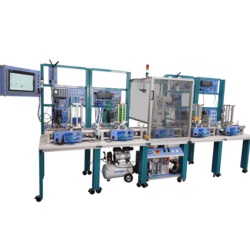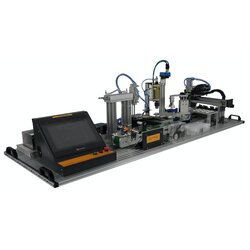Automated Factory Programmable Manufacturing Cell (DL CIM-PMC)
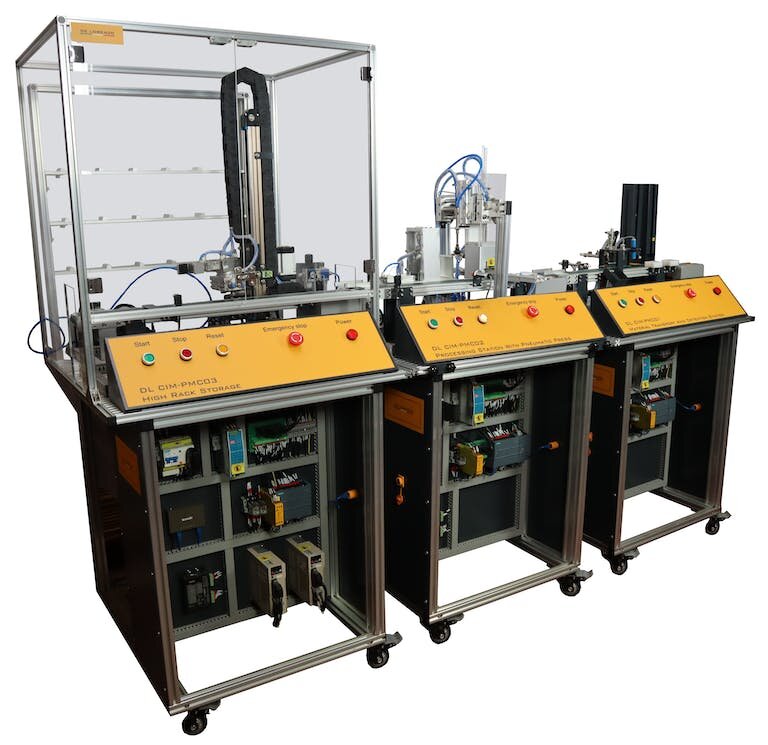

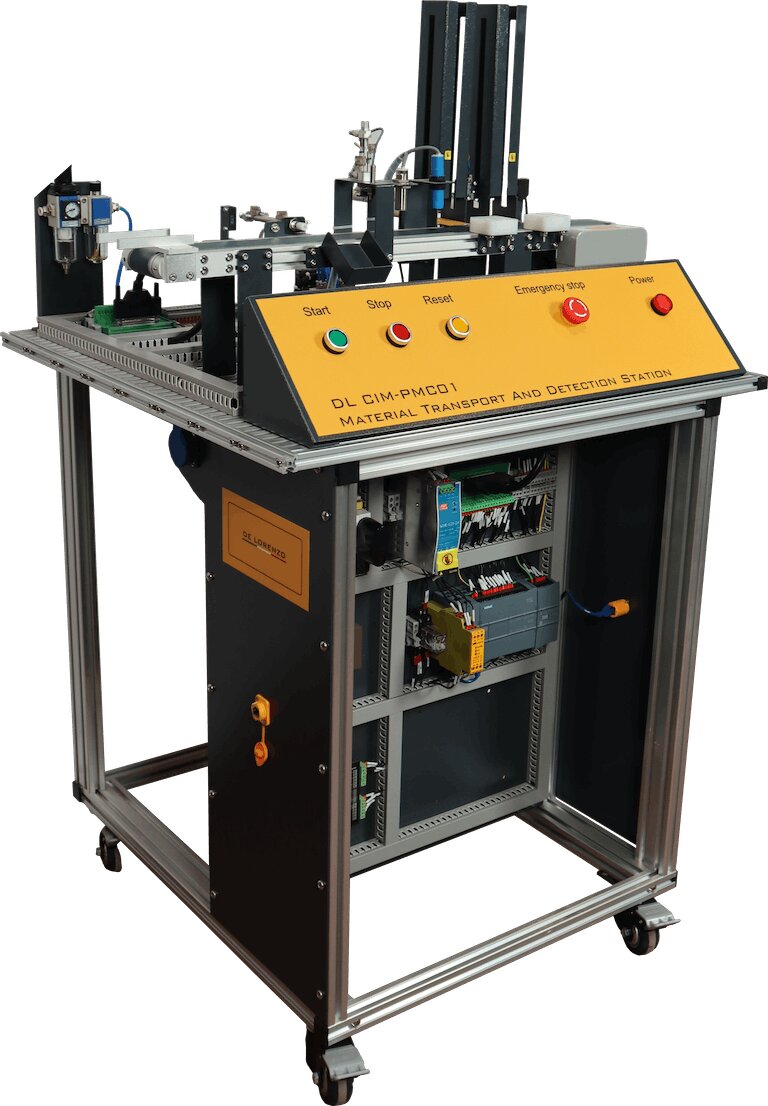
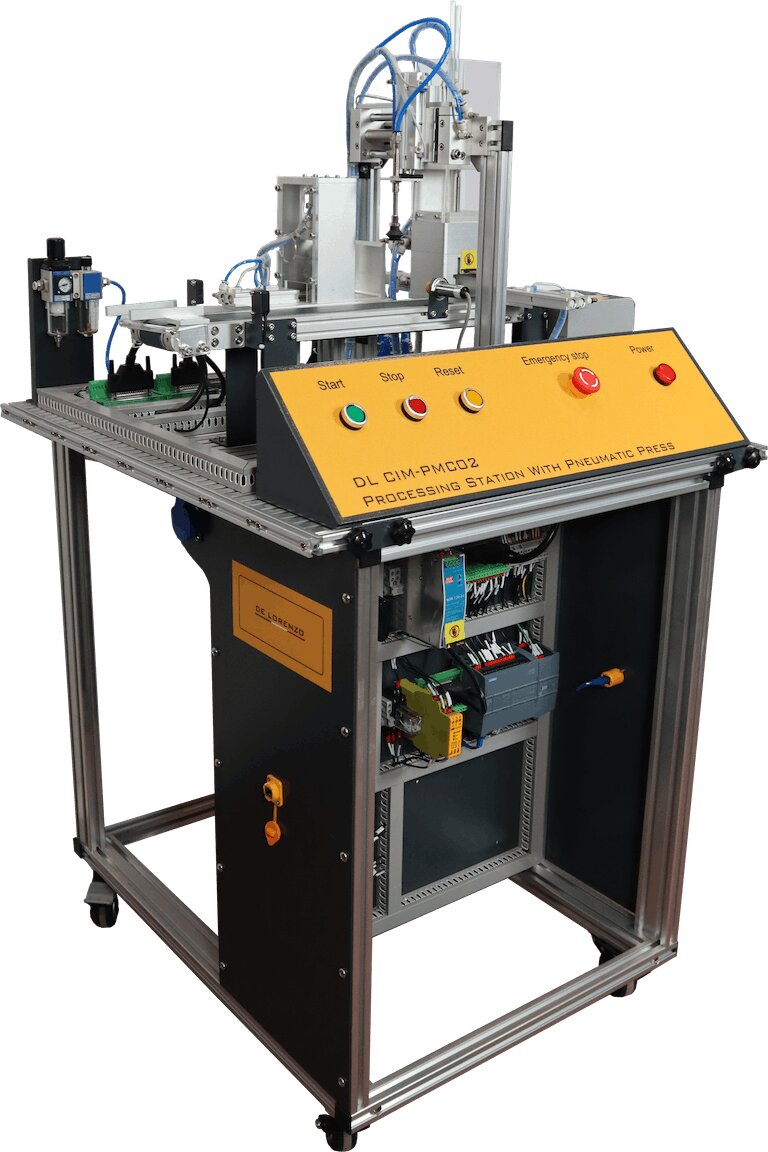

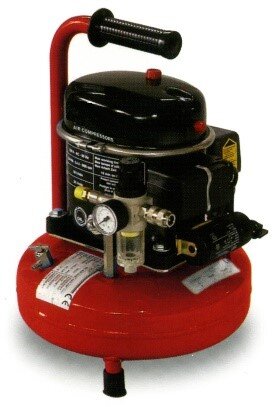
PL-650505
CIM (computer integrated manufacturing) is a manufacturing method, in which the entire production process is automated and controlled by computer to reduce the errors and increase its efficiency.
The DL CIM-PMC is station-based modular training system, that simulates an automated factory. Each manufacturing cell is controlled by a programmable logic controller (PLC) that allows the automation of the processes and the operation of the industrial production line.
It is a closed- loop control based on PLC that exchanges information collected from sensors and covers CIM system functional areas like design, analysis, planning, purchasing, cost accounting, inventory control, or more applied functions: materials handling and management, direct control, and monitoring of all the operations.
COMPOSITION
The system is composed of 3 main sections that can be used stand-alone or combined in a full production line:
DL CIM-PMC01: Material detection and transport station.
DL CIM-PMC02: Processing station with pneumatic press.
DL CIM-PMC03: Storage station with vertical warehouse.
In case of a combined purchase, the measurements and weight indicated must be multiplied by 3.
TARGET
Ideal for 4 students to work simultaneously. Vocational and technical schools Applicable to courses in: Automation, Electronics, Mechatronics, Electro pneumatics and Process Control.
TRAINING OBJECTIVES
The trainer focuses on the study of a programmable manufacturing cell and implementation of an industrial process. It demonstrates the role and the integration of the typical actuators (electric, pneumatic) into process executions.
The performances of the actuators influence the quality of industrial automation functions. Together with the sensors, they ensure and increase the value of manufacturing processes.
Sensors, actuators and transducers work together, allowing the students to perform practices on different topics related to automation such as:
- PLC programming.
- Material transport with conveyor belt.
- Using sensor for product detection (material, colour, and position).
- Understanding of an assembly process system.
- Use of a Cartesian robot with pneumatic gripper.
HIGHLIGHTS
The DL CIM-PMC is a compact solution that covers many transversal applications and didactic topics in the areas of Automation, Pneumatics, Mechatronics, Electronics, and Process Control.
It not only uses a proof of concepts approach; but it also simulates a real application of industrial sensors and actuators, programmable logic control (PLC), and dedicated information and computer technologies (ICT-s).
All training topics are designed to understand the CIM main functions and components, where the sensors collect the information needed for inspections and handling, the actuators execute the process, and the PLC monitors and controls manufacturing algorithms.
The trainer implements sequential operations, with some automated parallel work. Each substation can be studied separately learning about its specific components and functionalities of each manufacturing phase:
- Material transport and detection.
- Product assembly.
- Storage and Warehouse management.
The provided CIM software for PLC shows the openness of the system for expansion, or customization. At the same time, it can be a ready-for-industry implementation solutions because it has been tested on the CIM trainer.
KEYWORDS
Computer Integrated Manufacturing, Automation, Pneumatics, Mechatronics, Electronics, Process Control, Industrial processes applications, Flexible Manufacturing Systems, design, analysis, planning, materials handling, direct control, manufacturing cell, PLC.
AUTOMATED FACTORY MATERIAL TRANSPORT AND DETECTION STATION DL CIM-PMC01 CIM (computer integrated manufacturing) is a manufacturing method, in which the entire production process is automated and controlled by computer to reduce the errors and increase its efficiency. The DL CIM-PMC01 reproduces a scaled-down material detection and transport station. The manufacturing cell is controlled by a programmable logic controller (PLC) that allows the automation of the processes and the operation of the industrial production line. It is a closed- loop control based on PLC that exchanges information collected from sensors and covers CIM system functional areas like design, analysis, planning, purchasing, cost accounting, inventory control, or more applied functions: materials handling and management, direct control, and monitoring of all the operations. PROCESS DESCRIPTION The automated factory simulates the assembly of cubes composed of two parts, a metal base and a plastic lid (black and white), joined together with plugs. The DL CIM-PMC01 is the first station in the chain. It is composed of 2 vertical feed bins that contain the raw material (lower and upper parts of the cube). When a part is discharged on the belt, different sensors will detect its material, colour, and drilled hole before travelling to the next station to be processed or being discarded. TARGET Ideal for 4 students to work simultaneously. Vocational and technical schools Applicable to courses in: Automation, Electronics, Mechatronics, Electro pneumatics and Process Control. TECHNICAL FEATURES The DL CIM-PMC01 includes: • Feed bin unit: used to store raw materials, consisting of upper metal feed bin and lower plastic feed bin. Both are equipped with a sensor to detect the feeding shortage, as well as a discharge cylinder. The Feed bin contains 12 lower metal covers, 6 black upper plastic covers, 6 white upper plastic covers and 1 lower undrilled metal cover for waste material detection. Housing cubes made of aluminum and Plastic covers (white and black). • Detection unit: Different sensors are available to detect different materials qualities: Photoelectric sensor, Capacitive sensor, Inductance sensor, Fiber optical sensor, Magnet switch. • Conveyor unit: forwards the work pieces and connects the workstations. The conveyor belt is driven by a stepper motor with adjustable speed. • Control panel for monitoring the system in real time that includes indicator lights (power on, stop, start, reset) and an emergency stop button. • Siemens PLC-CPU1214C: o Includes the software for programming the PLC. o 32 I/Os at 24 Vdc: 22 input 10 outputs. o Communication interface. • Power supply: AC power supply single-phase 3-wire. The station is supplied with programming software, connection cables and working cubes. TRAINING OBJECTIVES The trainer focuses on the study of a programmable manufacturing cell and the functionality of a material transport and detection station. It demonstrates the role and the integration of the typical actuators (electric, pneumatic) into process executions. The performances of the actuators influence the quality of industrial automation functions. Together with the sensors, they ensure and increase the value of manufacturing processes. Sensors, actuators and transducers work together, allowing the students to perform practices on different topics related to automation such as: • PLC programming. • Material transport with conveyor belt. • Using sensor for product detection (material, colour, and position). AUTOMATED FACTORY PROCESSING STATION CIM (computer integrated manufacturing) is a manufacturing method, in which the entire production process is automated and controlled by computer to reduce the errors and increase its efficiency. The DL CIM-PMC02 reproduces a scaled-down processing station with pneumatic press. The manufacturing cell is controlled by a programmable logic controller (PLC) that allows the automation of the processes and the operation of the industrial production line. It is a closed- loop control based on PLC that exchanges information collected from sensors and covers CIM system functional areas like design, analysis, planning, purchasing, cost accounting, inventory control, or more applied functions: materials handling and management, direct control, and monitoring of all the operations. PROCESS DESCRIPTION The automated factory simulates the assembly of cubes composed of two parts, a metal base and a plastic lid (black and white), joined together with plugs. The DL CIM-PMC02 received the inspected material and relative information from the DL CIM-PMC01. The metal base, after having the pins inserted, is placed in the press where it is assembled with a plastic lid. The assembled cube is placed back on the belt and transferred to the next station for storage. TARGET Ideal for 4 students to work simultaneously. Vocational and technical schools Applicable to courses in: Automation, Electronics, Mechatronics, Electro pneumatics and Process Control. TRAINING OBJECTIVES The trainer focuses on the study of a programmable manufacturing cell and the functionality of an assembly station with a pneumatic press. It demonstrates the role and the integration of the typical actuators (electric, pneumatic) into process executions. The performances of the actuators influence the quality of industrial automation functions. Together with the sensors, they ensure and increase the value of manufacturing processes. Sensors, actuators and transducers work together, allowing the students to perform practices on different topics related to automation such as: • PLC programming. • Sensor setting. • Understanding of an assembly process system. TECHNICAL FEATURES The DL CIM-PMC02 includes: • Pin assembly unit: insert 2 pins into the lower metal base. It consists of a material positioning mechanism, pin supply mechanism and pin assembly mechanism. It includes a shortage alarms and cylinders for intercepting, and pushing the metal base in the unit, and for feeding and pressing in the pins. • General assembly unit: assemble the upper plastic cover and the lower metal cover, completing a finished cube. It consists of a transfer mechanism with a vacuum gripper to place the material on the assembly mechanism which includes the press cylinder. • Conveyor unit: forwards the work pieces and connect the workstations. The conveyor belt is driven by a stepper motor with adjustable speed. Includes a light barrier for material detection at the conveyor’s end. • Control panel for monitoring the system in real time that includes indicator lights (power on, stop, start, reset) and an emergency stop button. • Siemens PLC-CPU1214C: o Includes the software for programming the PLC. o 44 I/Os at 24 Vdc: 26 input 18 outputs. o Communication interface. • Power supply: AC power supply single-phase 3-wire. The station is supplied with programming software, connection cables and working cubes. AUTOMATED FACTORY STORAGE STATION CIM (computer integrated manufacturing) is a manufacturing method, in which the entire production process is automated and controlled by computer to reduce the errors and increase its efficiency. The DL CIM-PMC03 reproduces a scaled-down vertical warehouse storage station. The manufacturing cell is controlled by a programmable logic controller (PLC) that allows the automation of the processes and the operation of the industrial production line. It is a closed- loop control based on PLC that exchanges information collected from sensors and covers CIM system functional areas like design, analysis, planning, purchasing, cost accounting, inventory control, or more applied functions such as materials handling and management, direct control, and monitoring of all the operations. PROCESS DESCRIPTION The automated factory simulates the assembly of cubes composed of two parts, a metal base and a plastic lid (black and white), joined together with plugs. The DL CIM-PMC03 received the inspected material and relative information from the DL CIM-PMC02. The assembled cube is placed in an empty slot of the warehouse based on its colour and the position predefined by the user. At the end of the process, the cubes can be manually extracted from the warehouse by opening the doors. TARGET Ideal for 4 students to work simultaneously. Vocational and technical schools Applicable to courses in: Automation, Electronics, Mechatronics, Electro pneumatics and Process Control. TRAINING OBJECTIVES The trainer focuses on the study of a programmable manufacturing cell and implementation of a storage warehouse system. It demonstrates the role and the integration of the typical actuators (electric, pneumatic) into process executions. The performances of the actuators influence the quality of industrial automation functions. Together with the sensors, they ensure and increase the value of manufacturing processes. Sensors, actuators and transducers work together, allowing the students to perform practices on different topics related to automation such as: • PLC programming. • Sensor setting. • Use of a Cartesian robot with pneumatic gripper. TECHNICAL FEATURES The DL CIM-PMC03 includes: • Servo drive robot unit: Cartesian robot for placement on high rack storage system, consisting of 2 electric servo axes, one pneumatic gripper, one pneumatic rotary axis and a pneumatic axis for moving the gripper to the conveyor or into the storage area. • Storage unit: vertical aluminium structure with 15 locations (3 rows x 5 columns) to store the finished cubes assembled in the previous stations. • Conveyor unit: forwards the work pieces and connect the workstations. The conveyor belt is driven by a stepper motor with adjustable speed. Includes photoelectric sensors for positioning. • Control panel for monitoring the system in real time that includes indicator lights (power on, stop, start, reset) and an emergency stop button. • Siemens PLC-CPU1214C: o Includes the software for programming the PLC. o 28 I/Os at 24 Vdc: 14 input 14 outputs. o Communication interface. • Power supply: AC power supply single-phase 3-wire The station is supplied with programming software, connection cables and working cubes. NECESSARY ACCESSORIES (optional) Single-Phase Electro-Compressor DL 8110SLZ With very low noise level for small capacity. Tank capacity: 24 litres Air intake: 50 litres/min. Max. working pressure: 8 bar or 116 PSI Motor power: 0.34 kW or 0.45 HP Noise level: 40 dB Dimensions: 40 x 40 x 60 (h) cm. Weight: 25 kg.What is this?
These percentage scores are an average of 0 user reviews. To get more into detail, see each review and comments as per below
If you have used this product, support the community by submitting your review
